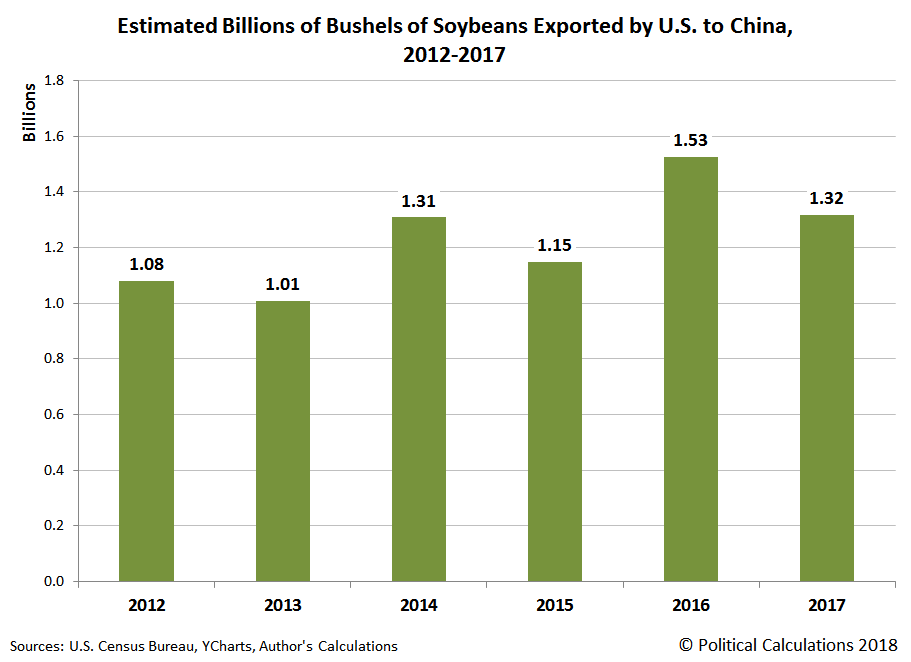Trade Wars: China's "Madman" Retaliation
Overnight, the trade wars between the U.S. and China sharply escalated, when China's leaders communicated their seriousness to retaliate against tariffs announced by President Trump by targeting 106 U.S. products, including one in particular that will directly harm regular Chinese citizens: soybeans.
China will struggle to replace U.S. soybean supplies after implementing an additional 25 percent tariff on American shipments, likely inflicting severe financial pain on domestic companies, analysts and executives at feedmakers said.
The world’s top importer of the oilseed will impose the tariffs on soybeans and 105 other U.S. products, state broadcaster CCTV said on Wednesday, an expected retaliation following Washington’s aggressive trade actions.
Soybeans are considered one of the most powerful weapons in Beijing’s trade arsenal because a drop in exports to China would hurt Iowa and other farm states that backed U.S. President Donald Trump. Soybeans were the biggest U.S. agricultural export to China last year at a value of $12 billion.
The following chart shows the annual value of soybeans shipped by the U.S. to China over the six-year period from 2012 through 2017, as reported by the U.S. Census Bureau through its USA Trade Online site.

The next chart converts those billions of dollars into their equivalent billions of bushels based on the prices of soybeans from 2012 through 2017. If it looks familiar, we featured it earlier this year when we examined the dark side of success for U.S. soybean exports.

China's inclusion of soybeans in its list of U.S. products targeted for retaliation in the escalating trade war between the two nations is highly significant in that this single agricultural product dominates all other U.S. farm exports to China.
(Click on image to enlarge)
Beyond that, it is also highly significant because China's people would feel the pain from its leaders proposed tariff on U.S. soybeans.
China gobbles up about 60 percent of globally traded soybeans to feed the world’s largest livestock industry. Factories crush the oilseed to make meal - a key ingredient in animal feed.
“There simply aren’t enough soybeans in the world outside of the U.S. to meet China’s needs,” said Mark Williams, chief Asia economist at Capital Economics.
“As for reducing dependence on imports, there are a few options, but none is a magic bullet that could hurt U.S. farmers without generating costs at home.”
Brazil supplied half of China’s imports last year while the United States shipped around 33 million tonnes, about a third of the total. Replacing those U.S. tonnes will be no easy feat.
ZeroHedge explains why China's inclusion of retaliatory tariffs on U.S. soybeans is so surprising:
What makes the inclusion of soybeans so surprising?
Perhaps nothing more than the fact that while China is seeking to hurt US exporters, it will also substantially and materially impair its own domestic producers and supply chains, will struggle to replace U.S. soybean supplies "inflicting severe financial pain on domestic companies, analysts and executives at feedmakers said" according to Reuters, and potentially risk sparking runaway food inflation as surging feedstock prices send pork prices through the roof.
To be sure, from a trade war perspective the inclusion of soybeans makes perfect sense: for China, the world's top importer of the oilseed in the world, soybeans are considered one of the most powerful weapons in Beijing’s trade arsenal because a drop in exports to China would hurt Iowa and other farm states that backed U.S. President Donald Trump....
There certainly isn't enough production at home: China grows only about 14 million tonnes of soybeans, mainly to make food for human consumption, making it especially reliant on foreign imports, and thus, the US.
In short, by crippling US soybean imports, China may have shot itself in the leg.
As such, China would appear to be trying to get a proverbial leg up by using the same kind of "madman negotiation technique" that President Trump used successfully to establish negotiations with North Korea.
And while the irony of that is sweet, the impact of China's "madman"-inspired tariff retaliation are being felt directly in U.S. stock market futures, which were hammered, as you might expect, within minutes of China's announcement.
Disclaimer: Materials that are published by Political Calculations can provide visitors with free information and insights regarding the incentives created by the laws and policies described. ...
more


